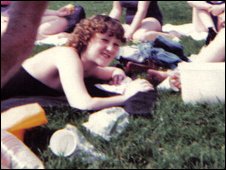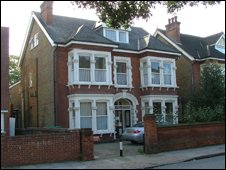By Angus Stickler
BBC Today
April 7, 2009
http://news.bbc.co.uk/today/hi/today/newsid_7982000/7982021.stm
 |
| Every single day I wanted to die and because I couldn't die I'd cut myself up. Teresa Cooper |
The physical, sexual and emotional abuse in children's homes through the 1970s and 1980s is well documented.
But it is possible that hundreds of women, who were in care homes across the UK in that period, have handed down a more devastating legacy to their own children.
A group of former residents of a children's home, run by the Church of England, in Kent have revealed that the girls were given massive doses of tranquilisers.
Now those girls have gone on to have children of their own; children who were born with a range of birth defects.
Teresa Cooper was one of those girls. She arrived at Kendall House in Kent at the age of 14. Over the 32 months she was there, she was given medication at least 1,248 times - cocktails of 11 different drugs.
She says of her arrival: "I didn't want to go in. I knew something was wrong. There was bars on the window.
"The first thing that they did in the morning when we woke up is that, we went downstairs and they made me line up for tablets.
"Nobody told me what they were, what they were for - they just told me that it was for my own good. I remember, one of the girls, the first thing she said to me is that I had better take the tablets and not argue it."
Teresa also recounts being held down by up to six members of staff in order to be sedated.
But she had no mental illness - her "problems" were according to reports "caused wholly by very difficult home circumstances". Rather than being placed in a recommended boarding school, she was placed at Kendall House.
Chemical cosh
 |
| Kendall House in Kent is no longer a children's home |
The Home Office consultant psychiatrist in charge, Dr Perinpanyagam, has said in the past that the drugs used by the staff at the home were safe and did not have side effects.
Dr Perinpanyagam has since died.
However, evidence shows the girls were, for years, given drugs which had been strongly criticised by the Royal College of Psychiatrists.
Teresa, for instance, was given major tranquillisers: Haloperidol, Droleptan and Depixol. She was also given valium, diazepam up to 10 times the current recommended dose and Sparine, another major tranquilliser.
Jeffrey Aronson, professor of clinical pharmacology at Oxford University, says he has not seen a situation to compare and that the amounts and types of drugs given to Teresa were "unacceptable".
"That would act as what people used to call a chemical cosh if you like - a cosh - something that knocks you out…this girl is being given large amounts of drugs that act on the brain in many different ways.
"Even in the 1980s, for a 14-year-old girl, with no history of psychiatric illness whatsoever, who is in a home for social reasons, to be given large doses of many different psychoactive drugs in this way is very, very unusual."
Teresa says the effect on her was devastating. "Every single day I wanted to die and because I couldn't die I'd cut myself up," she says.
 |
| Changes in genes and chromosomes induced by drugs may lead to birth defects or abnormalities later in life. Professor Jeffrey Aronson |
"I'd break pens, I'd break anything that could cut, anything, if I could pull a nail out of the bed or do something - I'd use that - I'd slice myself up.
"Because I didn't feel the pain really - you don't feel the pain - you're so drugged you don't feel it. You just know that when you're doing it there's some sort of relief - because you can physically see that you're bleeding and that's your pain coming out."
Birth defects
Teresa left Kendal House in 1984 at the age of 16 - and went on to have a family.
New evidence suggests that the drugs the girls were given may have caused genetic damage, which was passed on to their children in the form of birth defects.
Teresa has had three children: her eldest son was born with respiratory problems, her second born blind with learning difficulties.
Her third, Sarah, is now 16, and has been in and out of hospital all her life. She was born with a small jaw, known as Pierre Robin Syndrome, and a cleft palate.
Teresa says: "I had literally just given birth [to Sarah] and all of a sudden all these doctors appeared from nowhere - and nobody would talk to me.
"You know, they were all just rushing around my baby - which was fine - I didn't hear her cry - I actually thought she was dead at first and they took her off and took her to intensive care."
The trauma of her childhood has affected Teresa. "I tried to commit suicide and I put myself in intensive care and my daughter went to the hospital with me. She watched them try and resuscitate me and I hated myself for it...because I saw what it done to her."
Teresa decided to track down other girls from Kendall House to see if they were having similar problems.
She found that 10 of the girls had gone on to have children with birth defects. Those girls were all given drugs. Two girls she contacted who were not drugged had children without birth defects. "I noticed that they started having birth defects such as brain tumours - hydrocephalus, learning difficulties - and it wasn't with one or two girls - it's like four, five six and the numbers start going up.
"We were young girls - we were going through puberty as well - and I do believe those drugs did something and they affected us.
 |
| Sarah Cooper was born with a small jaw and a cleft palate |
"If it's happening to us there could be others out there it's happening to. We don't know whether it's because we were so severely overdosed or whether it is just a normal problem if you give that to a teenage girl for example."
Perfectly acceptable
Prof Aronson looked at the range and number of drugs Teresa was given and said that there is evidence that the drugs could have caused birth defects in her children.
"Changes in genes and chromosomes induced by drugs may lead to birth defects or abnormalities later in life," he says.
"But the fact that there were 10 of them affected in this is quite suggestive."
The Church of England has issued a statement which said that it could not comment on individual circumstances.
"However, if the police, social services or appropriate legal body initiates an investigation, the Diocese [of Rochester] will cooperate fully with them," the statement says.
"It would be inappropriate for the Diocese to initiate any internal enquiries since we are not qualified to do this. In any event, it would be essential for any investigation to be conducted both professionally and impartially."
In all, the BBC investigation identified six other children's homes using drugs. Tracking them down is more difficult - the records simply do not exist.
Mike Lindsay, chief adviser at the office of the Children's Rights Director based in Ofsted, is currently on secondment as national co-ordinator for the Children's Rights Alliance, England.
He worked in an assessment centre in south London in the early 1980s.
He confirms that there could be hundreds of children in care whose behaviour was controlled with the use of drugs.
"Using drugs to control the behaviour of children was perfectly acceptable as far as their own professional understanding at that time went," he says.
"I think there was a lot of it going on."
Any original material on these pages is copyright © BishopAccountability.org 2004. Reproduce freely with attribution.